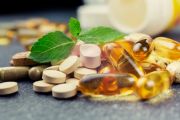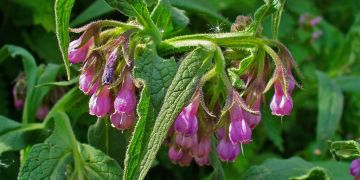Habitat
Comfrey grows well in North America and Europe as well as many other places because it adapts well to a variety of soil types. However, because the comfrey plant looks very similar to other herbs that can be very deadly, you should not attempt to harvest it yourself unless you have been trained to do so by a skilled herbalist.
Parts of the Plant Used for Medicinal Purposes
Historically, the leaf, root, and rhizome have all been used to make herbal medicines. Today, it is known that the roots contain 10-16 times the amount of poisonous pyrrolizidine alkaloids than the leaves have, and new leaves contain more of the unwanted substance than older ones do. Other factors, such as the time of harvest, also impact the final chemical makeup of the leaves. Today, reputable companies produce comfrey preparations that use only the leaves of the plant. However, it is very important to read the ingredients list and label directions carefully and to research the manufacturer of your comfrey product before you use it.
Active Ingredients
Comfrey contains allantoin, a naturally occurring chemical which is known to help new skin cells form. It also contains other substances that encourage skin health and help to reduce inflammation. These substances make it a natural choice for muscle and ligament injuries, sprains, strains and broken bones. It may also be effective in the treatment of osteoarthritis, but because it is not safe for long-term use, it has limited applications for arthritis and other chronic conditions. Because comfrey contains at least eight different poisonous pyrrolizidine alkaloids that are absorbed through the skin and build up in the liver, it cannot be used on many skin conditions that involve openings in the skin, such as abrasions or skin ulcers.
Available Forms
Comfrey products in the United States, the United Kingdom and much of Europe are limited to creams, liniments and ointments intended for topical use only. Ointments are typically the most concentrated of these products, containing between five and 20 percent comfrey. Look for products that state specifically that they are made from the leaves of common comfrey. Avoid products that contain roots, stems or rhysomes. Also be certain to buy from reputable companies, since only one variety of comfrey, Symphytum officinale, also known as common comfrey, is considered safe enough for medicinal use. Some products labeled Symphytum officinale have been found to contain other types of comfrey, such as Symphytum asperum, commonly known as prickly comfrey, or Symphytum x uplandicum, commonly called Russian Comfrey.
Risks
Comfrey contains large amounts of a deadly pyrrolizidine alkaloids. These chemicals accumulate in the liver and cause irreversible damage and even death. As a result, comfrey is no longer taken internally, and oral preparations containing the herb are now banned in the United States, the United Kingdom and most of Europe. Topical preparations are still used in adults, but they should only be made from certain parts of the plant and must not be used on broken skin or for more than ten days.
Drug Interactions
Because a large number of medications and herbal preparations have the potential to interact dangerously with comfrey, consult your health care provider or pharmacist before using comfrey along with any other prescription or over-the-counter medications or herbal products.





